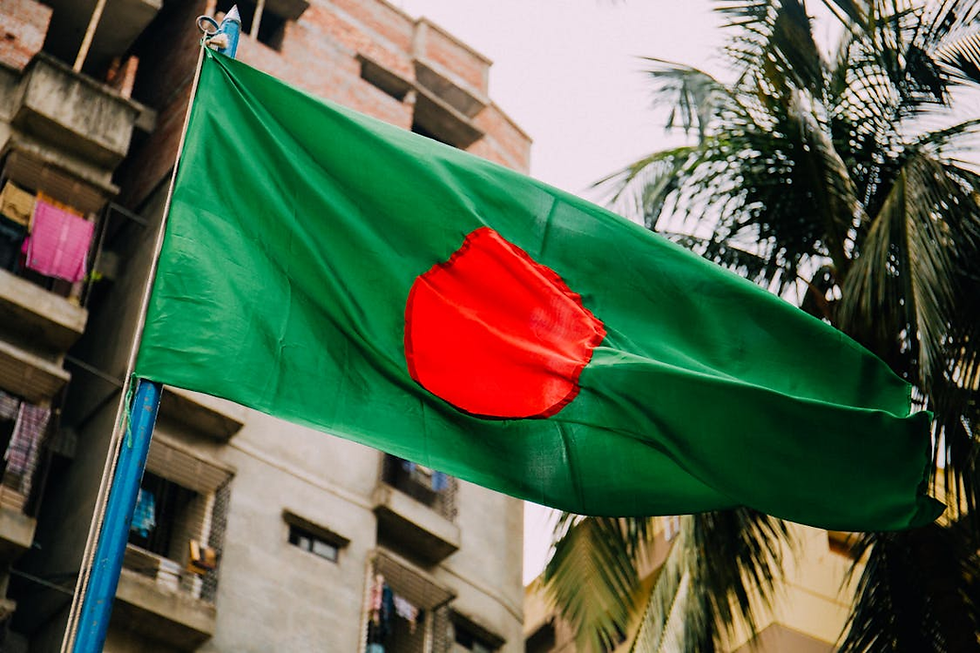India's Role in the 1971 Liberation of Bangladesh: A Timeline
- Sparsh

- Aug 29, 2023
- 4 min read
Updated: Dec 23, 2024
Content warning: This article contains descriptions and images of violence which readers may find upsetting.
The year 1971 marked a defining moment in South Asian history as India played a pivotal role in the liberation of Bangladesh: a country born out of the ashes of a brutal conflict. This article explores India's extraordinary contribution to this war and the circumstances that led to its involvement.

Background
The origins of the 1971 Bangladesh Liberation War can be traced back to the tumultuous history of Pakistan: a nation born out of the 1947 partition of India. East and West Pakistan were geographically separated by India, with a stark cultural, linguistic, and economic divide. East Pakistan, home to the Bengali majority, faced discrimination and oppression from the ruling elite in West Pakistan.
The Language Movement and Early Unrest
The first signs of unrest appeared in 1948 when the Bengali Language Movement began, demanding recognition of Bengali as an official language. The conflict escalated in 1952 when Pakistan's armed forces launched an offensive, leading to tragic casualties. Tensions simmered further as General Yahya Khan refused to convene parliament following the 1970 Prime Ministerial elections.
Election of 1970 and Awami League's Victory
In the 1970 elections, the Awami League, led by Sheikh Mujibur Rahman, secured a resounding victory in East Pakistan. Their win led to profound implications, as the Awami League was set to draft Pakistan's third constitution. Their six-point agenda aimed at greater autonomy for the Bengalis, separate currencies, fiscal authority for federating units, and the right to maintain a separate militia in response to West Pakistan's cultural, economic, and political marginalization of East Pakistan.
The Brutality of “Operation Searchlight”
When the West Pakistani government refused to transfer power, General Yahya Khan initiated "Operation Searchlight" in March 1971: a military crackdown aimed at crushing the demand for autonomy. During this period, up to 30 lakh (3 million) Bengali Hindus lost their lives, and around one crore (10 million) sought refuge in India, with up to 3 crores (30 million) internally displaced.
Dhaka's Old City was set ablaze with flamethrowers, and thousands were machine-gunned as they fled. The Mass rape of Women was systematic, with Pakistani mullahs publicly declaring Bengali women to be 'gonimoter maal' (public property). Troops acted with impunity, following the lead of their Commander, who vowed to 'change the race of the Bengalis.'
Around 4 lakh (400,000) Bengali women suffered, with many losing their lives. The Women Under Siege Project documented atrocities, revealing that victims ranged from 8-year-old girls to 75-year-old women. After the war, 'Birangona' (“brave women”) was coined by Sheikh Mujibur Rahman to combat the social stigma endured by these survivors. This brutal campaign resulted in mass casualties and a flood of refugees into neighboring India.
The Refugee Crisis and India's Dilemma
India faced an enormous challenge as millions of refugees sought shelter from the violence. However, launching an offensive would be fraught with risks, including monsoons and the difficult terrain of East Pakistan. Moreover, India had to ensure that China, Pakistan's ally, wouldn't intervene, leading to a careful timing of the operation.
International Diplomacy and India's Military Intervention
India appealed to the international community for assistance but received no substantive response. Faced with the humanitarian crisis, Prime Minister Indira Gandhi decided that it was more economically feasible to go to war than take in millions of refugees. In April 1971, the Indian Cabinet ordered General Sam Manekshaw to prepare for military intervention.
The Indo-Pakistani War and Operation Trident
In November 1971, General Sam Manekshaw informed Prime Minister Indira Gandhi about the Indian army's readiness to support Mukti Bahini fighters, a guerrilla resistance force consisting of the Bangladeshi military, paramilitary and civilians. Pakistan launched "Operation Chengiz Khan" on December 3, 1971, attacking Indian air bases. This marked the beginning of a 13-day war.
India's Coordinated Offensives
In response, India launched "Operation Trident," targeting the Karachi port. The Indian Air Force quickly achieved air supremacy, and the navy effectively blockaded East Pakistan's ports. India's forces coordinated efforts with the Mukti Bahini, which allowed them to navigate difficult terrain and approach Dhaka swiftly.
Pakistan's Surrender and Birth of Bangladesh
On December 16, 1971, Pakistan's Lt. Gen. AAK Niazi signed the Instrument of Surrender, marking the end of the Bangladesh Liberation War. Over 93,000 Pakistani troops surrendered, making it the largest surrender of personnel since World War II. Bangladesh sought UN admission, though China vetoed it due to its alliance with Pakistan.
Conclusion: India's Unwavering Support
India's role in the Bangladesh Liberation War of 1971 showcased remarkable coordination, diplomatic efforts, and military prowess. The nation's support for the Bengali people's quest for freedom was instrumental in the creation of Bangladesh. Attaining independence in 1971 not only gave Bangladesh its freedom from the clutches of oppressive East Pakistan, but changed the history and geopolitical scenario of South Asia. Now, India and Bangladesh are close strategic partners in counter-terrorism. They are also the largest trading partners in South Asia.

_edited.png)




Comments